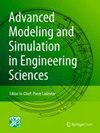基于样条的试件形状优化鲁棒材料模型校准
IF 3.2
Q3 MECHANICS
Advanced Modeling and Simulation in Engineering Sciences
Pub Date : 2022-01-05
DOI:10.21203/rs.3.rs-1153344/v1
引用次数: 0
摘要
现场测量识别允许从单个测试中识别多个参数,前提是测量对要识别的参数足够敏感。为了做到这一点,作者使用经验定义的几何形状(有孔、缺口……)。优化样品以最大化测量灵敏度的第一次尝试与设计空间相关联,该设计空间要么很小(参数优化),这不允许探索非常不同的设计,或者相反,非常大(拓扑优化),这有时会导致不规则的设计,无法制造。本文提出了一种基于非侵入式cad优化策略的中间方法。它依赖于单变量样条自由变形盒的定义来减小设计空间,从而使问题正则化。然后,从建模的角度出发,提出了一个考虑实验设置的新目标函数,并增加了约束函数,以确保增益真实,形状物理合理。实例表明,该方法在不改变实验装置的情况下,以较低的成本显著提高了本构参数的识别效果。本文章由计算机程序翻译,如有差异,请以英文原文为准。
Spline-based specimen shape optimization for robust material model calibration
Identification from field measurements allows several parameters to be identified from a single test, provided that the measurements are sensitive enough to the parameters to be identified. To do this, authors use empirically defined geometries (with holes, notches...). The first attempts to optimize the specimen to maximize the sensitivity of the measurement are linked to a design space that is either very small (parametric optimization), which does not allow the exploration of very different designs, or, conversely, very large (topology optimization), which sometimes leads to designs that are not regular and cannot be manufactured. In this paper, an intermediate approach based on a non-invasive CAD-inspired optimization strategy is proposed. It relies on the definition of univariate spline Free-Form Deformation boxes to reduce the design space and thus regularize the problem. Then, from the modeling point of view, a new objective function is proposed that takes into account the experimental setup and constraint functions are added to ensure that the gain is real and the shape physically sound. Several examples show that with this method and at low cost, one can significantly improve the identification of constitutive parameters without changing the experimental setup.
求助全文
通过发布文献求助,成功后即可免费获取论文全文。
去求助
来源期刊

Advanced Modeling and Simulation in Engineering Sciences
Engineering-Engineering (miscellaneous)
CiteScore
6.80
自引率
0.00%
发文量
22
审稿时长
30 weeks
期刊介绍:
The research topics addressed by Advanced Modeling and Simulation in Engineering Sciences (AMSES) cover the vast domain of the advanced modeling and simulation of materials, processes and structures governed by the laws of mechanics. The emphasis is on advanced and innovative modeling approaches and numerical strategies. The main objective is to describe the actual physics of large mechanical systems with complicated geometries as accurately as possible using complex, highly nonlinear and coupled multiphysics and multiscale models, and then to carry out simulations with these complex models as rapidly as possible. In other words, this research revolves around efficient numerical modeling along with model verification and validation. Therefore, the corresponding papers deal with advanced modeling and simulation, efficient optimization, inverse analysis, data-driven computation and simulation-based control. These challenging issues require multidisciplinary efforts – particularly in modeling, numerical analysis and computer science – which are treated in this journal.
 求助内容:
求助内容: 应助结果提醒方式:
应助结果提醒方式:


